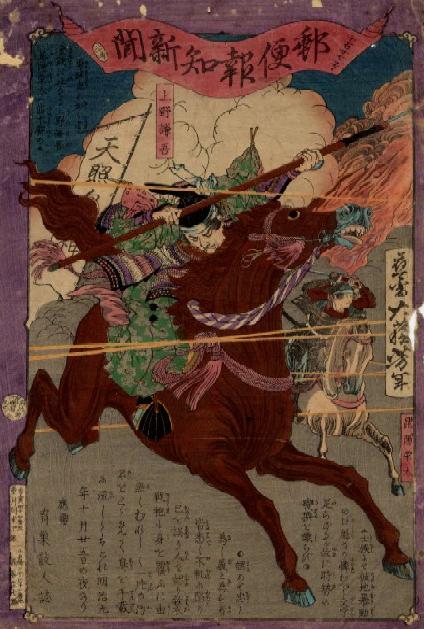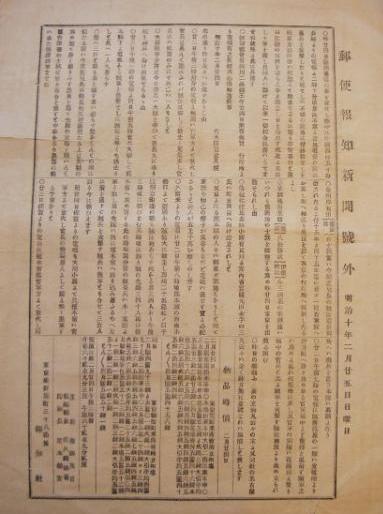No. 1127 (Series 20) 1876-10-29 Shinpuren rebellion Story in briefThe Shinpuren rebellion began in Kumamoto on 24 October 1876. Ikuso Sanjin reports, in the story on this print, that the uprising had been suppressed by the following night. Ueno Kengo (上野堅吾) dominates the fighting on a brown horse, dodging bullets. His sidekick, Kaya Eita (昆陽 [カヤ] 栄太) follows on a white horse. This print features the characters 天照皇太神 (Tensho Kodaijin) -- aka Amaterasu Oomikami, the legendary divine progenitor of Japan and the Yamato race -- on a banner behind Ueno Kengo, the heroic elderly warrior who opposed foreign influence, shown extremely gallant on his brown stallion. (WW) |
||
CommentaryShinpurenUeno and other members of the Shinpuren (神風連) -- "divine wind alliance" -- were disenfranchised Kumamoto samurai who advocated a purer form of imperial restoration that would expel foreigners and foreign influence. Their actions sparked the Seinan War in January the following year. The war flared from February, and ended with the suicide of Saigo Takamori (1827-1877) in September. The Shinpuren saga inspired Mishima Yukio's Runaway Horses. Tensho KodaijinThe Tensho Kodaijin banner is reminiscent of the 天照皇 (Amaterasu Sumera) banner in the foreground of Yoshiiku's drawing of the 1872 Hokuetsu riots (TNS-50). The unnumbered keyblock print, YHS-9001, depicts some of the Shinpuren leaders and lists the names of many more Kumamoto rioters. The Shinpuren rebellion (神風連の乱 Shinpuren no ran) is also the theme of Yoshimura's Kumamoto rebels defeated (TNS-9004). Yoshimura, however, shows Ueno Kengo on a white horse.
Hochi extraThe incident reported in the story took place on 25 October 1876. Apparently this print was inspired by a "gogai" (号外) or "extra edition" of Yubin hochi shinbun that came out on the 29th -- four days later. It probably took Hochi that long to confirm the particulars of the disturbance. The image to the right shows an extra edition of Hochi dated 25 February 1877, related to the Seinan War. The war was sparked by a local disturbance in late January. Officials dispatched on a warship from Tokyo in early February reported that the imperial government army would have to be sent in to contain what appeared to be a spreading revolt led by Saigo Takamori. By 22 February, Saigo's Satsuma army had laid siege to Kumamoto castle, where a government force made up mainly of local conscripts and police had taken up defensive positions. Imperial regiments were unable to relieve the castle, and route Saigo's supporters, until April. (WW) |
Print information
Series: Yubin hochi shinbun
Issue: 1127 [Hochi 1876-10-29 gogai]
Series: 20
Date: Meiji 9-12-22 [1876-12-22] (otodoke)
Publisher: Kumagaya Shoshichi [Kinshodo]
Drawer: Tsukioka Yonejiro
Signed: (Oju) Taiso Yoshitoshi
Carver: Unsigned
Writer: (Oju) Ikuso Sanjin
Price: Not stated
Size: Oban
Image: University of Tokyo (Tsuchiya 2000)
Principal sources
Tsuchiya 2000
CCMA 2008

